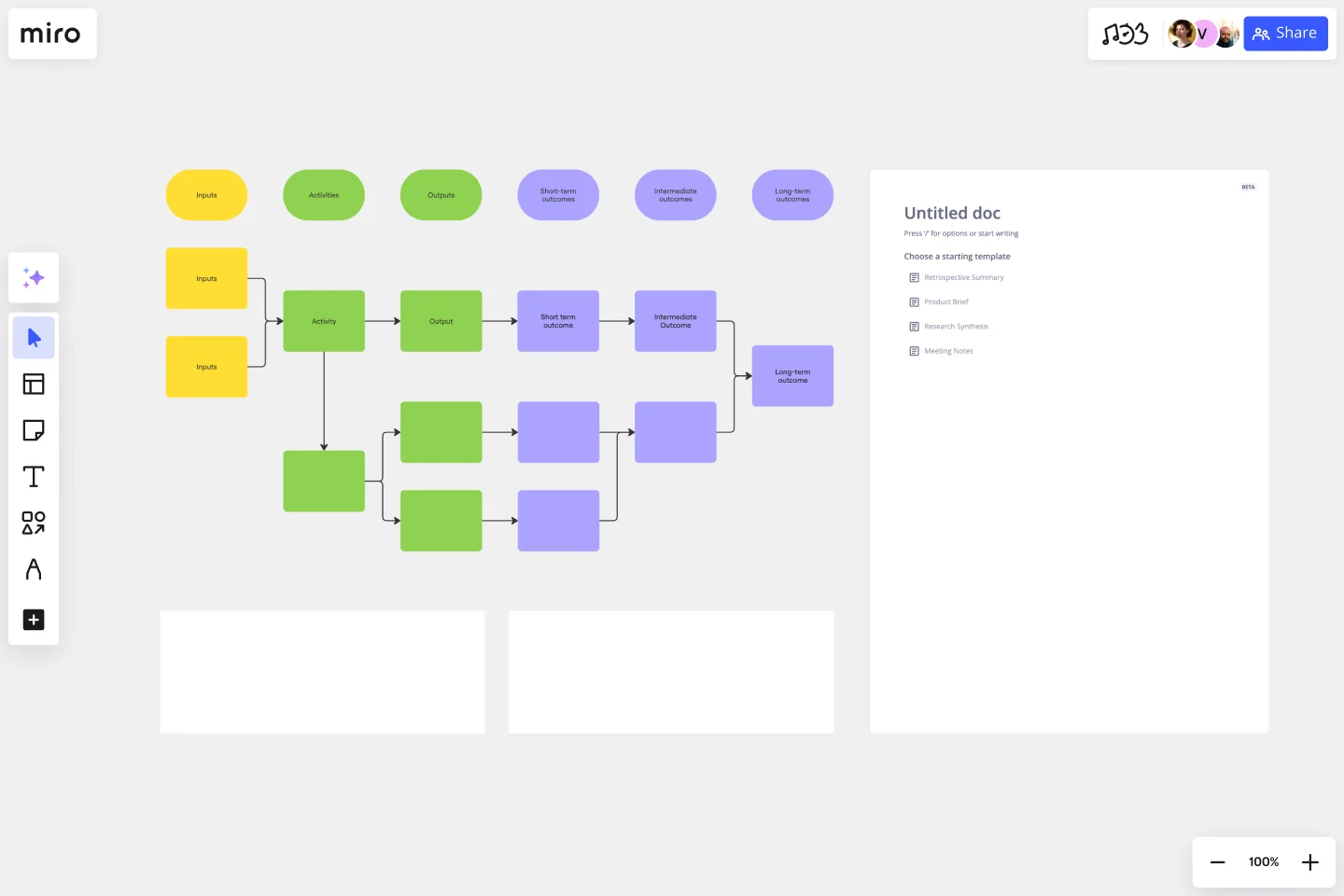Logic Model Template
Outline your program’s activities and outputs with the logic model template. Map out the project lifecycle and bring alignment to teams.
About the Logic Model Template
This logic model template offers an illustrative approach to program planning, evaluation, and management. The template visually represents the connection between resources, activities, and desired outcomes, ensuring a clear roadmap for your project or initiative.
Businesses, nonprofits, and educators can use the logic model template to visually depict the relationship between program inputs, activities, outputs, and outcomes. It illustrates how the invested resources will be transformed into the anticipated results through interconnected steps.
Step-by-step guide to using the logic model template
Setting up the logic model template to fit your project or business is easy. Start by opening the template onto a Miro board, then follow this guide to customize it to your needs.
Edit the template: Click on any element within the template to quickly edit or change it. You can change text, colors, or reposition sections as needed.
Expand with automated diagramming: If you need to add more sections or components, use Miro’s automated diagramming feature by clicking on shapes and connector lines. This lets you seamlessly expand and edit the existing structure of the template.
Add artifacts: To make your logic model more comprehensive, drag and drop any documents, images, links, or other artifacts onto the board.
Collaborate in real-time: Invite team members to join the board. They can provide instant input, comments, or feedback, ensuring a collaborative approach.
Share and collect feedback: Once your logic model is complete, you can share the board with stakeholders or team members for further review or implementation.
Why use a logic model template?
Clear visualization: The template provides a visual map, enabling stakeholders to quickly understand the entire project lifecycle and its components.
Improved resource allocation: Clearly defining inputs and anticipated outcomes ensures resources are used efficiently and directed toward activities that genuinely matter.
Alignment with goals: The template ensures all activities align with the overarching project or program goals, minimizing deviations or distractions.
Facilitates evaluation: With the logic model, it's easier to monitor and evaluate a program's effectiveness, pinpointing improvement areas.
Stakeholder communication: The template acts as a shared language, making communicating complex ideas or plans to different stakeholders simpler.
If you'd prefer to start from scratch, Miro's flowchart maker is the perfect tool to diagram a logic model. You can add shapes and connector lines with just one click.
Can I customize the logic model template?
The template is designed to be flexible, allowing you to tailor it according to your specific needs and preferences.
Can multiple team members collaborate on the template in real time?
The template supports real-time collaboration, ensuring all stakeholders can provide input and feedback instantly.
What kind of projects or initiatives is the logic model template best suited for?
The template is versatile and can be used for various projects, from educational initiatives and nonprofit programs to business projects and strategic planning.
Do I need any special skills to use the logic model template?
Not at all! The template is user-friendly, and even if you're new to such tools, you'll find it intuitive and easy to navigate.
Get started with this template right now.
Crowd Sourced Cause and Effect
Works best for:
Fishbone Diagram, Problem solving
The Crowd Sourced Cause and Effect template leverages collective intelligence to identify root causes of problems. By involving multiple team members, you can gather diverse perspectives and uncover insights that might be overlooked. This collaborative approach ensures a comprehensive analysis and fosters team engagement.
UML Class Diagram Template
Works best for:
UML Class Diagram Template, Mapping, Diagrams
Get a template for quickly building UML class diagrams in a collaborative environment. Use the UML class diagram template to design and refine conceptual systems, then let the same diagram guide your engineers as they write the code.
DMAIC Analysis Template
Works best for:
Agile Methodology, Design Thinking, Operations
Processes might not seem like the funnest thing to dive into and examine, but wow can it pay off—a more efficient process can lead to serious cost savings and a better product. That’s what DMAIC analysis does. Developed as part of the Six Sigma initiative, DMAIC is a data-driven quality strategy for streamlining processes and resolving issues. The technique is broken into five fundamental steps that are followed in order: Define, Measure, Analyze, Improve, and Control.
Affinity Diagram by UserPeek
Works best for:
Diagramming
The Affinity Diagram template is a visual tool for organizing and categorizing ideas, data, or issues into related groups. It provides a structured framework for conducting group brainstorming and affinity grouping activities. This template enables teams to synthesize information, identify patterns, and generate insights collaboratively. By promoting creativity and collaboration, the Affinity Diagram empowers teams to organize and prioritize information effectively, driving decision-making and problem-solving processes efficiently.
System Context Diagram
Works best for:
Diagramming
The System Context Diagram template is a visual tool for illustrating the relationships between a system and its external entities. It provides elements for depicting system boundaries, interfaces, and interactions with external stakeholders. This template enables teams to understand the broader context in which a system operates, facilitating requirements analysis and design decision-making. By promoting clarity and alignment, the System Context Diagram empowers teams to design systems that meet stakeholder needs and integrate seamlessly with their environment.
BPMN Template by Pavel Kuksa
Works best for:
Diagramming
The BPMN Template, elements, and example template offers a comprehensive visual notation for modeling business processes using the Business Process Model and Notation (BPMN) standard. It provides elements for defining process flows, activities, and decision points. This template enables teams to document and analyze business processes systematically, facilitating process optimization and automation. By promoting standardization and clarity in process modeling, the BPMN template empowers organizations to improve efficiency, agility, and compliance in their operations.
